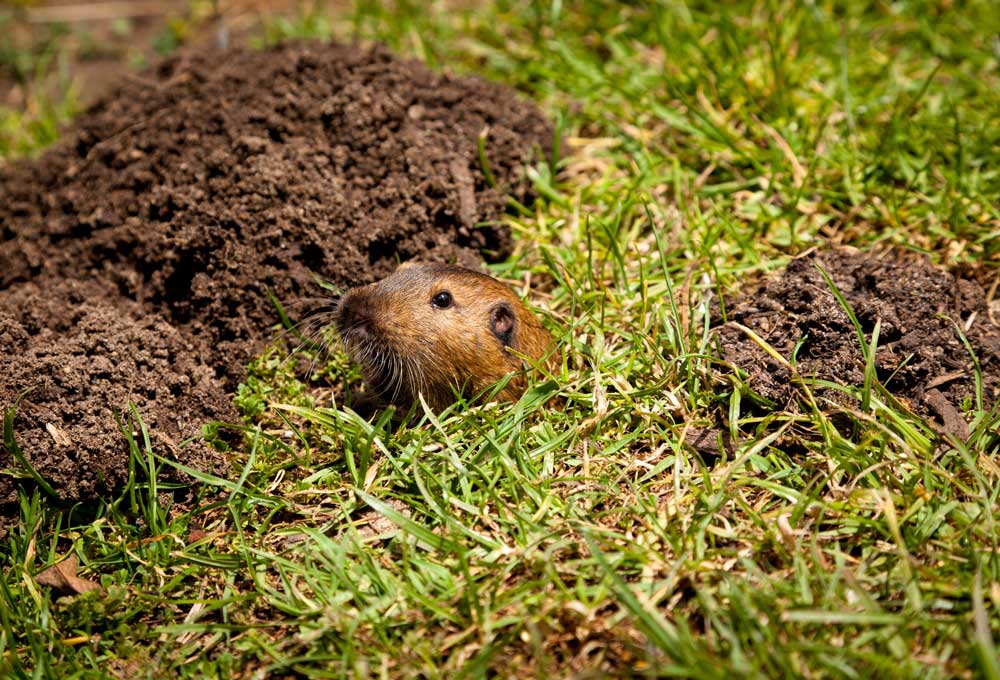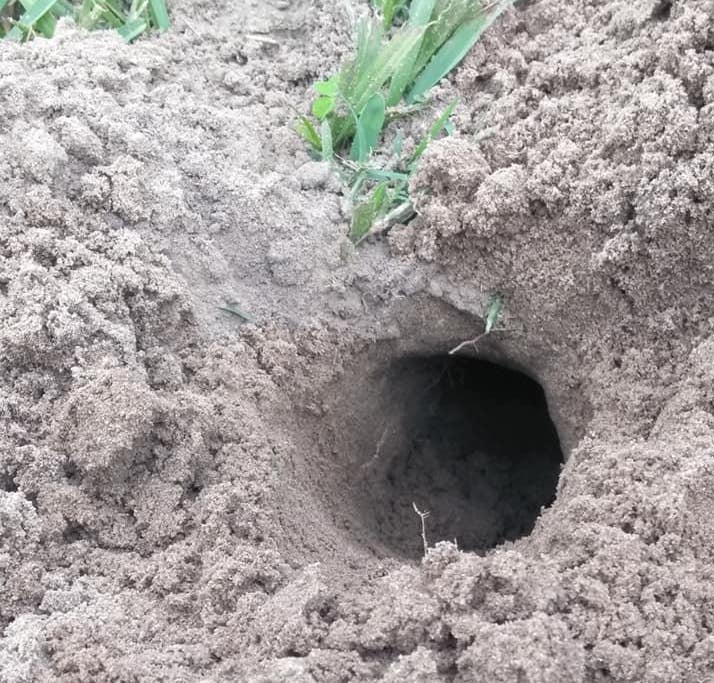You may not see gophers, but the evidence of their activities on your lawn will be hard to miss. These underground dwellers will dramatically enter your property if they can access it and have something to attract them there- vegetation, shelter, moisture, and the absence of predators.
Getting rid of gophers before they destroy your lawn is your responsibility, but how do you accomplish that? There are multiple gopher eradication techniques at your disposal, some more humane than others.
Continue reading to find out the best way to get rid of gophers.
What Are Gophers?
Gophers, also called pocket gophers, are tiny burrowing rodents in the family Geomyidae. They are commonly found in Central and North America, with some species inhabiting South America. In the United States, gophers inhabit the Southeast regions, the Great Plains, and the West.
These rodents have stout bodies with short legs and powerful claws made for digging. They typically range in size from 6 to 8 inches (15 to 20 cm) in length, with their tails adding another 2 to 3 inches (5 to 8 cm). Their fur can vary in color, including shades of brown, gray, or black.
Gophers are popular for their impressive digging skills as they often create an extensive network of tunnels underground. They construct complex burrow systems that consist of nesting chambers, food storage areas, and multiple entrance and exit holes.
These burrows help them find protection from predators and create suitable environments for their activities.
Gophers are herbivores, primarily feeding on plant matter like bulbs, roots, and tubers. This is why your garden or yard will appeal to them if there’s plenty of vegetation, causing damage to crops and gardens in the process.
Regarding their social life, gophers are solitary animals, preferring to live alone within their burrow systems. However, certain species, such as the plains pocket gopher, tolerate sharing tunnels with other members of their species.
Gophers have a relatively short gestation period, usually around three to four weeks. Females give birth to litters of several offspring, known as pups, generally ranging from 1 to 10. The young gophers mature quickly and become sexually active within a few months.
While gophers’ burrowing activities and potential damage to crops make them pests, these rodents also play a role in their ecosystems.
Their burrows can provide a habitat for other animals, and their digging contributes to soil aeration and nutrient mixing.
Related Posts:
Identifying Gopher Holes and Mounds
Since there are so many burrowing creatures, distinguishing between various holes and mounds can be challenging. So, are the holes and mounds in your yard gopher or the work of another burrowing rodent?
These are the characteristics of gopher holes and mounds.
a) Circular or Crescent-Shaped Mounds
In the process of developing their tunnels, gophers create mounds of soil that are typically crescent or horseshoe-shaped with a distinct opening in the center. In terms of size, they are generally a couple of inches to feet in diameter.
The circular or crescent shape will help you distinguish gopher mounds from others. For instance, molehills are more conical in shape.
b) Disturbed Soil
Gophers push soil out of their burrows when digging, creating a small mound or pile of soil nearby. Therefore, you will find disturbed soil or loose dirt around the gopher hole.
c) Plugged Holes
To protect themselves from predators, gophers partially cover or completely seal off the entrance to their burrows with a plug of soil. They do so with a soil plug or vegetation. This also helps regulate the airflow and temperature within the burrow.
d) Soil Texture
Gopher mounds feature loose soil excavated from the burrows. The soil feels loose and crumbly. Older dirt mounds are more compact, weathered, and lighter, while fresh ones are loose, moist, and dark.
e) No Visible Surface Tunnels
Unlike moles, gophers do not create visible surface tunnels since their burrows are primarily located underground. The mounds are the most visible sign of their activity. However, you may occasionally see small disturbances or depressions in the ground near the mounds.
f) Location
Gopher mounds are commonly found in open fields, meadows, gardens, lawns, and agricultural areas. Gophers burrow in areas with loose, well-drained soil because it is easier.
g) Observe the Pattern
Gopher holes and mounds are not randomly scattered. On the contrary, gophers create a network of tunnels underground, and mounds are formed where the tunnels intersect. If you see a series of mounds in a linear pattern, it indicates the direction of the gopher’s tunnel.
How To Get Rid Of Gophers

So, you have examined the holes and mounds in your garden or yard and determined that they belong to gophers. What’s next? You cannot let these rodents continue to live in your home, so the next move is to eradicate them.
Below are the proven solutions against gophers.
1. Trapping
Trapping is a popular method of gopher eradication for a reason. It is highly effective, environmentally friendly, cost-effective, and humane. With traps, you can specifically target the gophers causing damage to your property, placing them strategically to capture gophers while minimizing unintended consequences.
While there are kill traps, many traps are also designed to capture gophers alive, allowing you to relocate them to a more suitable location away from your property. Moreover, the impact of trapping on the environment is minimal.
This method is also relatively inexpensive and reusable. Once you have purchased or made traps, you can continue using them for future gopher control without ongoing expenditures.
Trapping is ideal if you have concerns about using pesticides or chemical toxins in your yard, especially if you have children, pets, or an organic garden.
2. Use Natural Repellents
Apply castor oil, garlic, or chili pepper on your garden or yard soil or mix any of these ingredients with water, then spray the solution in gopher-infested areas. You can also plant castor beans, daffodils, or marigolds to deter gophers.
Repellents usually contain ingredients that emit strong odors or tastes that gophers find unpleasant. However, the effectiveness of these repellents varies depending on the specific product, the gopher population, and the individual gopher’s behavior.
This is also a temporary solution and often requires repeated applications to maintain effectiveness. Therefore, if you use repellents, combine them with other methods like trapping. Also, take the environmental impacts of repellents into consideration since some contain chemical ingredients.
3. Predator Urine
The smell of predator urine, like coyotes and foxes, makes your garden or yard unwelcoming to gophers, so consider using a repellent with predator urine to deter gophers.
4. Ultrasonic Repellents
They are non-toxic, humane, safe for humans and pets, and easy to use. Ultrasonic repellents irritate gophers by emitting high-frequency sounds. However, their effectiveness depends on various factors like the repellent’s brand and model, the gopher’s proximity to the device, and the gopher’s behavior.
This method is appealing if you prefer a chemical-free and environmentally-friendly solution since it doesn’t involve chemicals or poison use. These devices also emit high-frequency sounds outside the range of human hearing, hence comfortable and harmless to humans and pets.
You also don’t have to handle any live or dead gophers since ultrasonic devices do not entail trapping or killing. Furthermore, you don’t need any skill to use these small, portable devices. Just place it on the ground or hang it near the problem area.
5. Attract Natural Predators
Gophers won’t feel safe staying on your property if your garden or yard also has gopher’s natural predators like owls, snakes, or cats. So, create habitats that attract these predators, such as installing owl boxes or allowing outdoor cats into your property to deter gophers.
The keen eyesight and aerial hunting abilities of raptor species like hawks and falcons make them effective in catching gophers in open areas. In that case, make your property appealing to them by creating perching sites or protecting nearby nesting.
Also, suitable habitats, such as rock piles or brush piles, can attract snakes to your property.
6. Exclusion
Render your home off-limits to gophers by erecting barriers to keep them from entering specific areas. This way, gophers can continue their natural behavior elsewhere, away from your garden or yard.
This method is ideal for protecting areas vulnerable to gopher damage, such as gardens, lawns, or ornamental plantings.
This long-term, environmentally-friendly solution is also versatile. You can tailor this technique to suit various situations and environments.
For example, you can install underground wire mesh barriers around garden beds, bury fences or hardware cloth around the perimeter of an area, or use specialized gopher baskets or cages for individual plants.
Note
Flooding gopher tunnels can drive these rodents away, but this approach can also damage your yard and vegetation, so it is best to avoid it. In addition, steer away from fumigation because the chemicals and gases used harm the environment. It also doesn’t address the underlying cause or prevent future infestation, and it requires specialized equipment, training, and proper handling.
Final Remarks
Consider effectiveness, safety, infestation severity, availability, and cost when choosing the technique to eliminate gophers. Non-lethal, chemical-free methods work better if you have pets and want to avoid releasing harmful substances into the environment.
However, ensure the method you pick is effective since getting rid of gophers remains the primary goal.

I’m Mike Hyle, an exterminator with 7+ years of experience handling all sorts of pests, including mice, cockroaches, bed bugs, and termites. I also write for Pest Solutions DIY blog to share my knowledge and help homeowners keep their homes pest-free. Outside work, I enjoy hunting, snowshoeing, and exploring nature. Check out my blog for helpful pest control tips!

